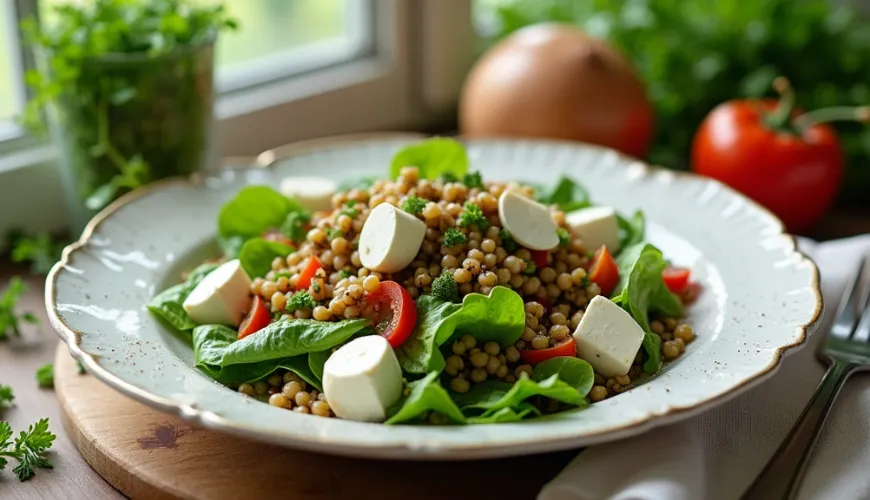
Discover the magic of honey-mustard dressing for perfect salads

Honey-Mustard Dressing - A Kitchen Miracle That Elevates Every Salad
When you hear "salad," many people imagine a quick meal that fills the stomach but often lacks a flavorful experience. This is where the dressing plays a key role. One of the most popular – and rightfully so – is the honey-mustard dressing, which can transform even the most ordinary leafy salad into a culinary delight. The combination of sweet honey, spicy mustard, and the acidic tones of balsamic or lemon creates a balanced harmony of flavors that is not only suitable for salads but also works as a marinade or dip.
Why is the Honey-Mustard Dressing So Popular?
The secret of its popularity lies in its simplicity and at the same time the complexity of its flavors. The sweetness of honey, the sharpness of mustard, and the acidity from balsamic vinegar or lemon create a perfect contrast that pairs well with many types of vegetables and proteins. Moreover, the dressing is versatile – you can use it on arugula, spinach, iceberg lettuce salads, as well as on roasted vegetables, grilled tofu, or chicken.
In gastronomy, it is often said that food is as much about taste as it is about emotions. The honey-mustard combination evokes a sense of homely comfort, freshness, and care – it's no wonder you'll find it both in home kitchens and on the menus of modern bistros.
What is Honey-Mustard Dressing Made Of?
The recipe for honey-mustard dressing is highly variable and can easily be adjusted to taste. The basic version usually includes these ingredients:
- 1 tablespoon of quality honey
- 1 tablespoon of Dijon mustard or whole grain mustard
- 2 tablespoons of olive oil
- 1 tablespoon of balsamic vinegar or fresh lemon juice
- Salt and freshly ground pepper to taste
Simply mix all the ingredients in a small bowl or shake them in a jar with a lid. The result is a creamy, slightly emulsified dressing that beautifully coats the vegetables and adds a touch of flair.
Balsamic or Lemon? And What About Other Variants?
The choice of acidic component is crucial as it defines the overall character of the dressing. Honey-mustard dressing with balsamic has a deeper, sweeter tone and is more suited to roasted vegetables or salads with nuts and cheese. The lemon version, on the other hand, is fresh and light, ideal for summer vegetable salads.
Some culinary variations also add a touch of garlic, yogurt for creaminess, or herbs like thyme or rosemary. You can achieve an interesting twist by adding a drop of sesame oil or soy sauce if you want the dressing to have an Asian flair.
Honey-Mustard Dressing on Salad
It might seem obvious, but even salad dressing needs to be applied properly. It's best to add it just before serving to prevent the leaves from wilting. If you're preparing a larger amount of salad in advance, you can keep the dressing separate and serve it at the table.
An interesting trick: lightly heat the dressing in the microwave or on the stove if you want to use it on a warm salad, such as one with roasted squash, sweet potatoes, and lentils. Warm dressing penetrates the ingredients better and enhances their flavor.
The dressing can also be excellently used as a marinade for meat or tofu. Let the protein marinate in this mixture for several hours in the refrigerator, then bake or grill it – the result will be juicy, fragrant, and full of flavor.
Experience from Practice
One of the common situations people encounter when changing their lifestyle is transitioning to a more plant-based diet. Salads become a daily part of the meal plan, but after a few days, they start to feel monotonous. This is exactly what happened to Martina, who decided to eat more fresh foods during a spring detox. "At first, I only added lemon and olive oil to the salad. After a week, I got totally bored with it. Then I discovered honey-mustard dressing, and everything changed. Suddenly, I was looking forward to the salad and began trying new combinations, like with pear and walnuts. It was a small thing, but it changed every lunch for me."
And that's precisely the magic of this dressing: it adds flavor and joy to food, which is often the most important thing when eating healthily.
Homemade versus Store-Bought
You can find several varieties of ready-made honey-mustard dressings on the market. Although they can be convenient, it's important to read the ingredients. Many of them contain sugar, preservatives, or thickeners, which are not ideal if you're trying to eat clean and healthy.
The homemade version has the advantage that you know exactly what's in it, and you can adjust it to your preferences – more honey for softness, more mustard for a kick, more balsamic for depth. Plus, you can make it in less than two minutes.
If you want to go even further, you can use local honey from a beekeeper or organic mustard without added substances. A sustainable approach in the kitchen doesn't have to be complicated – often, it just requires a conscious choice of ingredients.
What Does Honey-Mustard Dressing Pair Best With?
If you really want to get the most out of a good dressing's flavor, it's nice to think about what to serve it with – some foods can beautifully highlight and elevate its flavor profile. A great base is leafy greens like arugula, lamb's lettuce, or romaine lettuce; they are fresh, slightly bitter, or crunchy and seem to come alive with every drop of dressing. To that, you can add something sweeter, such as slices of pear, crunchy apple, or a few pomegranate seeds – all of which beautifully balance and at the same time enhance the flavor of the dressing.
Then we have the power of cheese: whether it's goat cheese, salty feta, or sharper parmesan, each of them adds not only richness to the salad but also the right dose of umami. When you add a few chopped nuts – like walnuts, pecans, or hazelnuts – you get texture that crunches and encourages you to savor every bite. And to round out the overall expression? Just add a handful of cooked lentils or chickpeas as a source of protein and satiety, or complement the salad with pieces of roasted vegetables – squash, carrots, or beets that, thanks to caramelization in the oven, combine with the dressing into an almost addictive combination of flavors.
So if you want your dressing not just to play a supporting role but to shine at its fullest, this is exactly how to bring it into the spotlight.
This combination of flavors creates a nutrient-rich yet tasty meal that satisfies and delights at the same time.
When Dressing is More Than Just Flavor
Nowadays, there is an increasing emphasis on the composition of food and its impact on health and the planet. Homemade honey-mustard dressing aligns with the principles of sustainable and healthy eating – it doesn't contain unnecessary chemicals, uses easily accessible ingredients, and supports a flexible, intuitive approach to the kitchen.
As the renowned chef Yotam Ottolenghi says, "Food is not just fuel; it's a story we tell ourselves every day." And with a little honey, mustard, and balsamic, that story can be surprisingly delicious.
All you need is a small jar of homemade dressing in the fridge, and every meal can be a notch better. In simplicity, there is beauty – and in this case, flavor.

